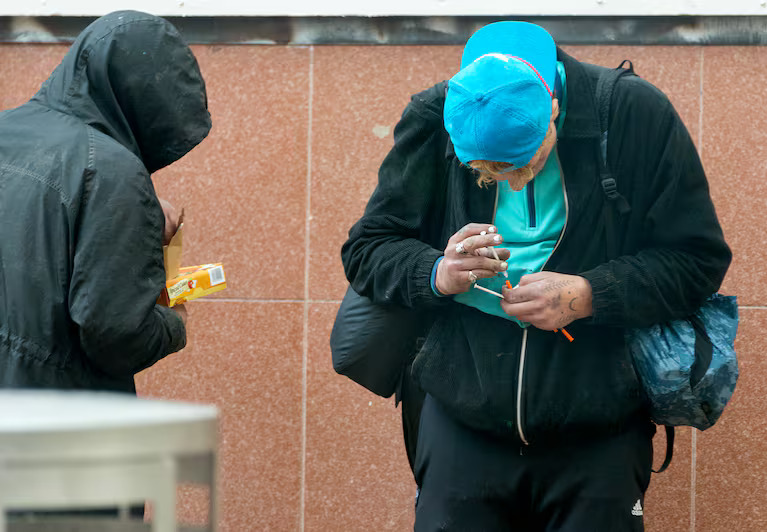Unidentified people use drugs in downtown Portland. (Kristyna Wentz-Graff/OPB)
Oregon counties eased into the state’s new approach to addressing fentanyl overdoses and drug addiction.
In its first four days, eight people in Oregon’s largest county agreed to participate in a deflection program intended to steer drug users away from courts and jail and into treatment or other recovery services, Multnomah County officials said Thursday in a press conference.
The eight people otherwise would have faced misdemeanor drug possession charges under House Bill 4002, which lawmakers passed this session to combat rising overdoses and public drug use. The law, which went into effect on Sunday, allows counties to set up deflection programs that allow people to avoid charges if they participate in recovery services.
Multnomah County and 27 other counties are planning to set up programs. But nowhere is the fentanyl addiction crisis more visible than in Portland, a metropolis that saw public drug use rise after voters passed Measure 110, which decriminalized low-level drug possession and put a share of cannabis revenue into addiction programs and services.The new law recriminalized drug possession, with the goal of sending people into treatment and related services, like housing and peer mentors, rather than filling jails.
But Oregon’s fight against fentanyl is a marathon, not a quick fix, officials and recovery workers say.
“We all know we still have a lot of work ahead of us because of the increased demand for and a chronic shortage of our services,” Multnomah County Chair Jessica Vega Pederson said. “We know that treatment is the most effective pathway to recovery. We’re dealing with a very challenging public health issue.”
Oregon lacks providers that offer drug addiction treatment and other services, like residential facilities to treat and shelter people. And it doesn’t have enough supportive housing with access to social services.
A state report found that Oregon is short by 3,700 beds for behavioral health facilities, which includes people who suffer addictions. State lawmakers allocated $211 million for services that include treating people in addiction, recovery housing and other programs.
But the programs will take time to expand and grow. Agencies need to hire people and facilities need to be built. And funding has to be disbursed.
In Multnomah County, officials have not yet opened a drop-off assessment center for people that police arrest. The center has secured $25 million in state funding to get off the ground and expand in the future.
Officials expect the center to open in mid to late October, but with a phased-in approach, with a goal to eventually be open 24 hours a day. The county has not finalized its timeline.
Without the center, police and outreach workers – like those from 4D Recovery Center in Portland – are making contact with people on the streets who suffer from addiction and try to engage them and encourage them to enter treatment or other services during the 30-day window they have before misdemeanor drug possession charges may be filed.
Tony Vezina, executive director of 4D, said it will take time to bring the services online.
“In this moment, everybody wants people to get help,” he said. “We’re just figuring out how to do it, and there’s going to be some hiccups along the way. But anything that you do that’s monumental or meaningful has hiccups.”
How it works
Under the county’s deflection plan, if someone is stopped by law enforcement and has illegal drugs for personal use, they will be eligible for recovery services if they have not committed any other crimes and have not failed deflection in the last month. Police officers still have the discretion to arrest a person or use the program.
To succeed, a person needs to complete a screening, receive a referral to services and engage with the recommended provider within 30 days. That doesn’t mean treatment has to start within 30 days. Based on an individual’s plan, they could take steps toward getting into housing or other services, like counseling.
Those who fail to engage within 30 days can be arrested and charged.
The outcome for those eight people will become more clear after that 30-day period. At this point, about 50% of people were able to get into some sort of service, Vezina said.
The numbers won’t tell the full story, either. Vezina said his team makes contact with people who don’t have contact with police and seek help. Those people are not counted in the deflection figures.
During that 30-day period, outreach workers – often people who overcame addictions themselves – will stay in touch with people as much as possible, building relationships and encouraging them to enter recovery.
For now, this is the system that Oregon has as it builds out deflection programs across the state.
“We know that we don’t have all the services we need here or across the state,” said Rachael Banks, director of the Multnomah County Health Department. “But we have to start somewhere, and we’re starting here, and every opportunity to connect with somebody is really a step towards building the system that we want.”
GET THE MORNING HEADLINES DELIVERED TO YOUR INBOX

